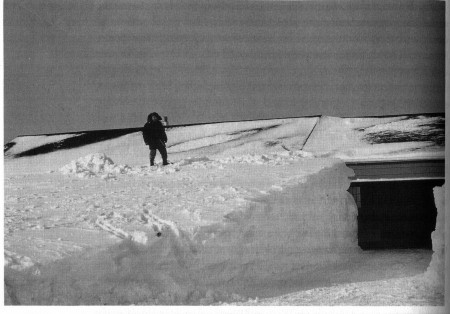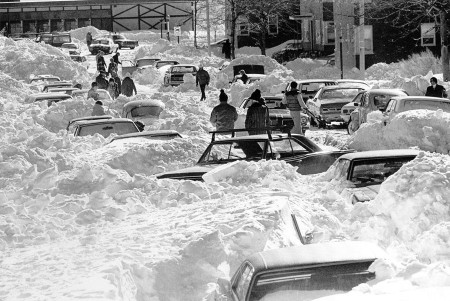A Mess Free Life may collect a share of sales or other compensation from the links on this page.
Did you know that September is National Emergency Preparedness month? So it’s the perfect time to think about what your family and home might need in case of a man made or natural disaster.
I’ve been a prepper, albeit in a small way, for years. It started in February of 1978. I was sixteen years old and was living in Massachusetts with my parents and sister, Eileen.

The Big One – The Blizzard of 1978

AP Photo
For those of you who have no recollection of the Blizzard of ’78 or who did not live in the Northeast corner of the United States, it was by all accounts an EPIC blizzard.
We were stuck in the house with zero access to the outside world for over a week. But because my father was always well prepared, we had an adequate supply of food and water.
I’ve learned a lot from my father about how to be prepared and continue to work on my family’s emergency plans each year.
If national disasters like Hurricane Katrina, major ice storms which leave people in the dark for weeks, or major blizzards which leave you cut off from the rest of the world for days don’t provide a good enough reason to get prepared, I don’t know what will.
You can read my posts on creating your emergency plan with your family and how to ensure an adequate supply of water in case of an emergency.
Today, we’ll look at making sure you have at least a three-day supply of food available to you in the case of an emergency. Storing a three-month supply of food should be your next goal followed by long-term storage.
Related: How To Prepare for Severe Weather
As many of you know, I’ve owned a professional house cleaning company for years. Because my team and I have cleaned hundreds of homes, and many for years on end, you get a good sense of how people live.
You’d be amazed how many people have no food storage. Zip. Nill. Natta.
No extra box of cereal, no canned fruit, not even an extra can of tuna fish or jar of peanut butter.
If there were a disaster, these people would seriously be up a creek without a paddle.
What most people don’t realize is that your local Stop and Shop has three days of food available on its shelf at any given time to feed the community. That’s it. I know it seems like far more when you’re pursuing the grocery store, but imagine a disaster where everyone in your community is vying for food. The shelves would be empty and unless there was a way to get more food to your town, you’d go hungry.
The Federal Emergency Management Agency (FEMA) recommends that all Americans have basic supplies on hand to survive for at three days if an emergency occurs. Non-perishable foods are your best bet.
Food Storage for Emergency Preparedness
To ensure your food storage is always up to date, make a list of everything in your stockpile and check expiration dates every 6 to 12 months to keep things fresh. Rotate your storage to ensure freshness. The best way to accomplish this is to put any new item into storage and use from your emergency supply. This way you know your storage has been rotated.
Don’t forget to have a MANUAL can opener on hand at all times—all that food won’t be of any use if you can’t open it.
Consider vacuum packing any foods like crackers, granola bars, dried fruits – anything that can be vacuumed sealed will last longer than if you just put it on the shelf and forget about it.
There are many on the market to choose from. I have a Food Saver System and have used it for over five years without a single problem. It’s easy to use too!
Related: Water Storage Tips for Emergency Preparedness
These items have lengthy expiration dates, so you can stash them away for long periods of time.
- Peanut butter: A great source of energy, peanut butter is chock-full of healthful fats and protein. Unless the jar indicates otherwise, you don’t have to refrigerate after opening. If you don’t like peanut butter, other nut butters will also do. Consider almond butter, cashew butter or the like.
- Whole-wheat crackers: Crackers are a good replacement for bread. Due to their higher fat content, whole-wheat or whole-grain crackers have a shorter shelf life than their plain counterparts (check the box for expiration dates), but the extra fiber pays off when you’re particularly hungry. Consider vacuum-packing your crackers to prolong their freshness.
- Nuts and trail mix: Stock up on these high-energy foods—they’re healthful and convenient for snacking. Look for vacuum-packed containers, which prevent the nuts from oxidizing and losing their freshness.
- Cereal: Choose multi grain cereals that are individually packaged, so they don’t become stale after opening.
- Granola bars and power bars: Healthy and filling, these portable snacks usually stay fresh for at least six months. Plus, they’re an excellent source of carbohydrates.
- Powdered milk: Almost all dairy products require refrigeration, so stock this substitute for a good source of calcium and vitamin D when fresh milk isn’t an option.
- Sports drinks, such as Gatorade or Powerade: The electrolytes and carbohydrates in these drinks will help you hydrate and replenish fluid when water is scarce.
- Canned soups and chili: Soups and chili can be eaten straight out of the can and provide a variety of nutrients. Look for low-sodium options.
- Canned vegetables, such as green beans, carrots, and peas: When fresh isn’t an option, canned varieties can provide you with essential nutrients.
- Dried fruits, such as apricots and raisins: In the absence of fresh fruit, these healthy snacks offer potassium and dietary fiber. Dried fruits provide a significant amount of calories and fiber. Consider vacuum sealing fruits to prolong freshness.
- Canned tuna, salmon, chicken, or turkey: Lasting at least two years in the pantry, canned meats provide essential protein. Vacuum-packed pouches have a shorter shelf life but will last at least six months, according to the USDA meat and poultry hotline.
- Boxed Milk (Almond, Coconut, Dairy): When you can’t fathom the idea of drinking powdered milk, these are a great and better-tasting alternative. They can be more expensive, so if your budget is limited, you’ll want to keep this in mind when deciding.
- Sugar, salt, and pepper: If you have access to a propane or charcoal stove, you may be doing some cooking. A basic supply of seasonings and sweeteners will improve the flavor of your food, both fresh and packaged.
- Multivitamins: Supplements will help replace the nutrients you would have consumed on a normal diet.
Make sure you have plenty of propane on hand for your gas grill. During power outages, it was the number one way I cooked most of my food. At the end of the summer, I make sure to fill my primary propane tank. Additionally, I always have another one on hand as a backup.
If you don’t have a gas grill or any way to cook food in an emergency, you may want to consider purchasing a solar oven. There are so many to choose from, and to be honest; I don’t own one yet although I’ve had my eye on the All American Sun Oven listed below for years. But it’s pricey and so I probably won’t buy it until sometime down the road.
There are many to choose from, and they range in price from under $100 to several hundred dollars. If you decide to add this to your preparedness supplies, you’ll have to consider how much cooking you’ll be doing with a solar oven to justify the expenditure.
Being prepared for an emergency requires you to consider everything from your family’s plan, water storage, food and much more.
It’s not if, but when an emergency will strike.
CONCLUSION
It really doesn’t take too much to get what you need in your home to ensure your family can eat during an emergency. Why not take the time and put your plan in place and stock some food supplies this week? Get prepared!
Check out all my Emergency Preparedness Article!


